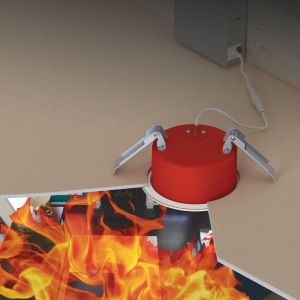In many homes and multi-family buildings, ceilings act as a critical fire barrier between living spaces or between a garage and the home’s interior; when you cut a hole in the ceiling to install a recessed fixture, you break that barrier. Building codes often require fire-rated downlights or enclosures to restore the ceiling’s fire resistance, helping to prevent flames and smoke from spreading quickly between floors or units in case of fire.
When You’ll Encounter These Requirements
These requirements are common for multi-family buildings and townhomes, where ceilings or floors separate dwelling units. Requirements are also common for ceilings that lie beneath attached garages or bonus rooms, as well as in two-story homes with finished basements or attics where penetrations connect one habitable level to another.
The exact rules can vary since jurisdictions may adopt stricter standards than the NEC. Always check the governing code in your area, such as the IRC or IBC, to confirm requirements with the proper local authority .
Benefits to Contractors Beyond Compliance
Using a factory-tested, fire-rated lighting solution saves time and labor as it eliminates the need for separate fire boxes. Clearly labeled fixtures give inspectors confidence in the installation, reducing the risk of failed inspections.
By using fire-rated lighting, you’re reinforcing your professional reputation by demonstrating that you prioritize occupant safety and property protection while building to the highest standard.
HALO Fire-Safe Solutions
HALO offers a full line of fire-rated canless downlights, housings, and a hybrid junction box housing. They’re engineered and tested to maintain the ceiling’s fire rating without requiring extra steps. These HALO solutions install with the same pro-focused features you already rely on, delivering both code compliance and jobsite efficiency.
One final pro tip: always verify the fixture’s listing and test standard (such as UL 263 or ASTM E119) and document it for inspectors. Even a quick photo of the product label can save you a costly return trip.


